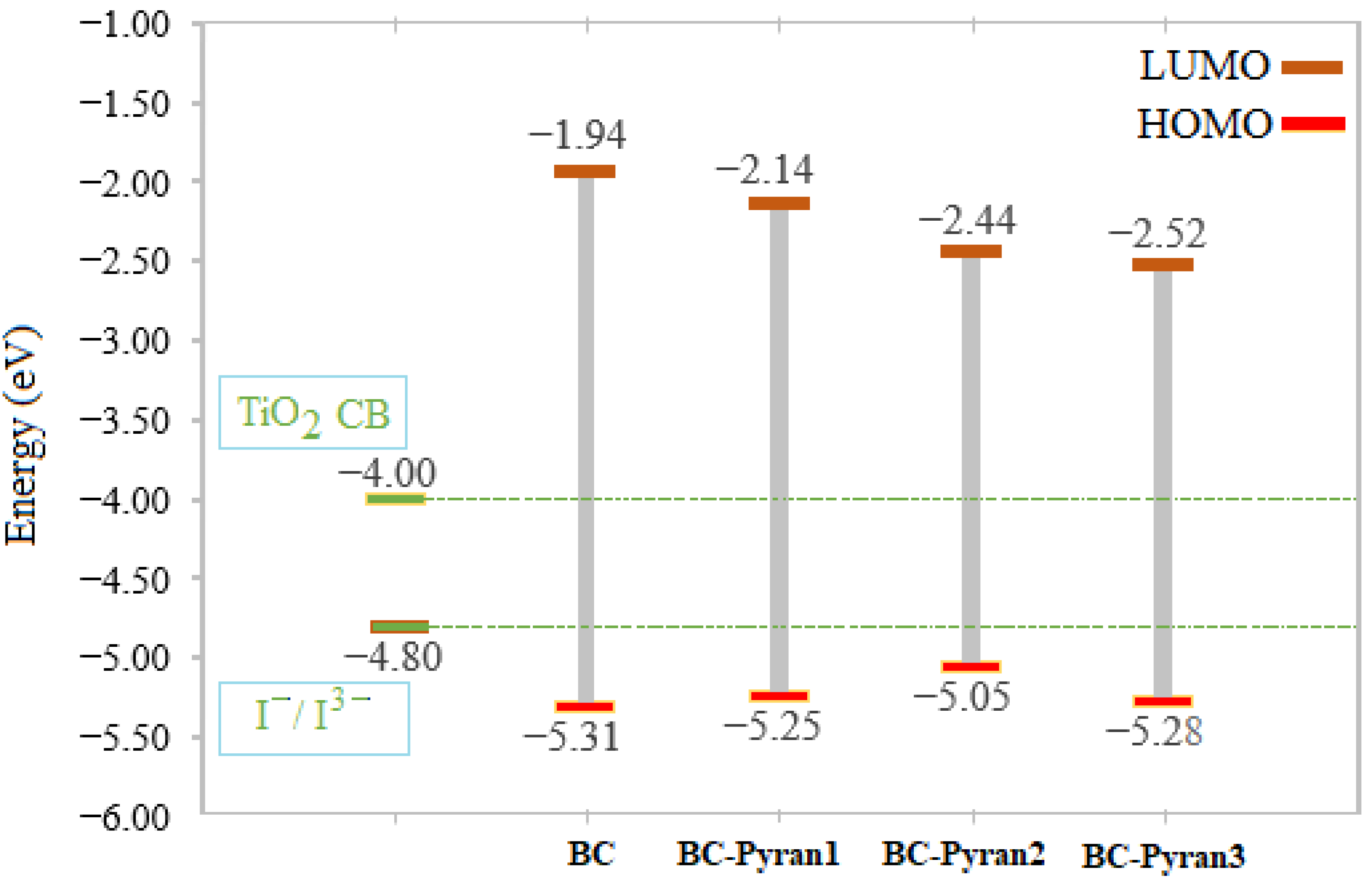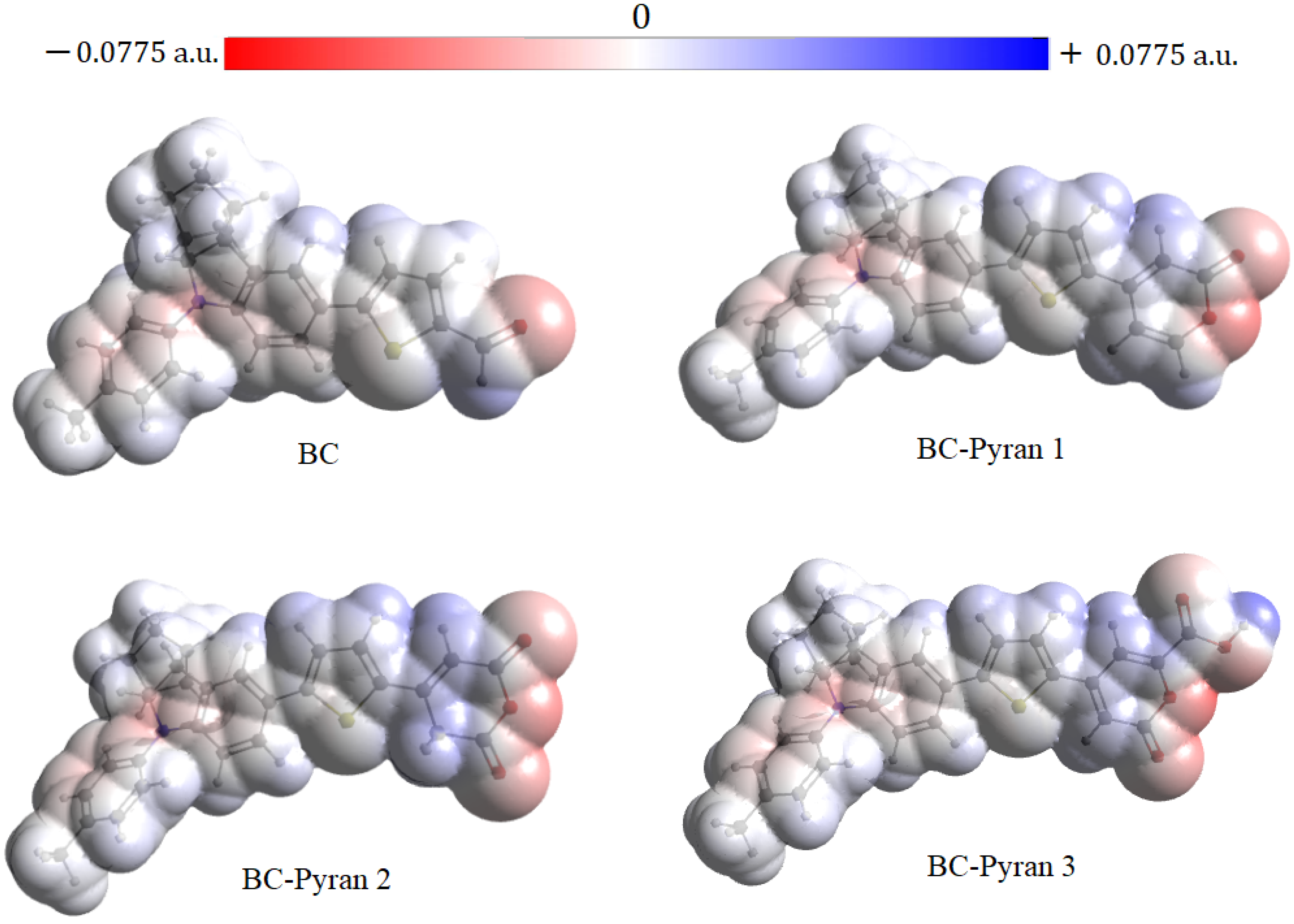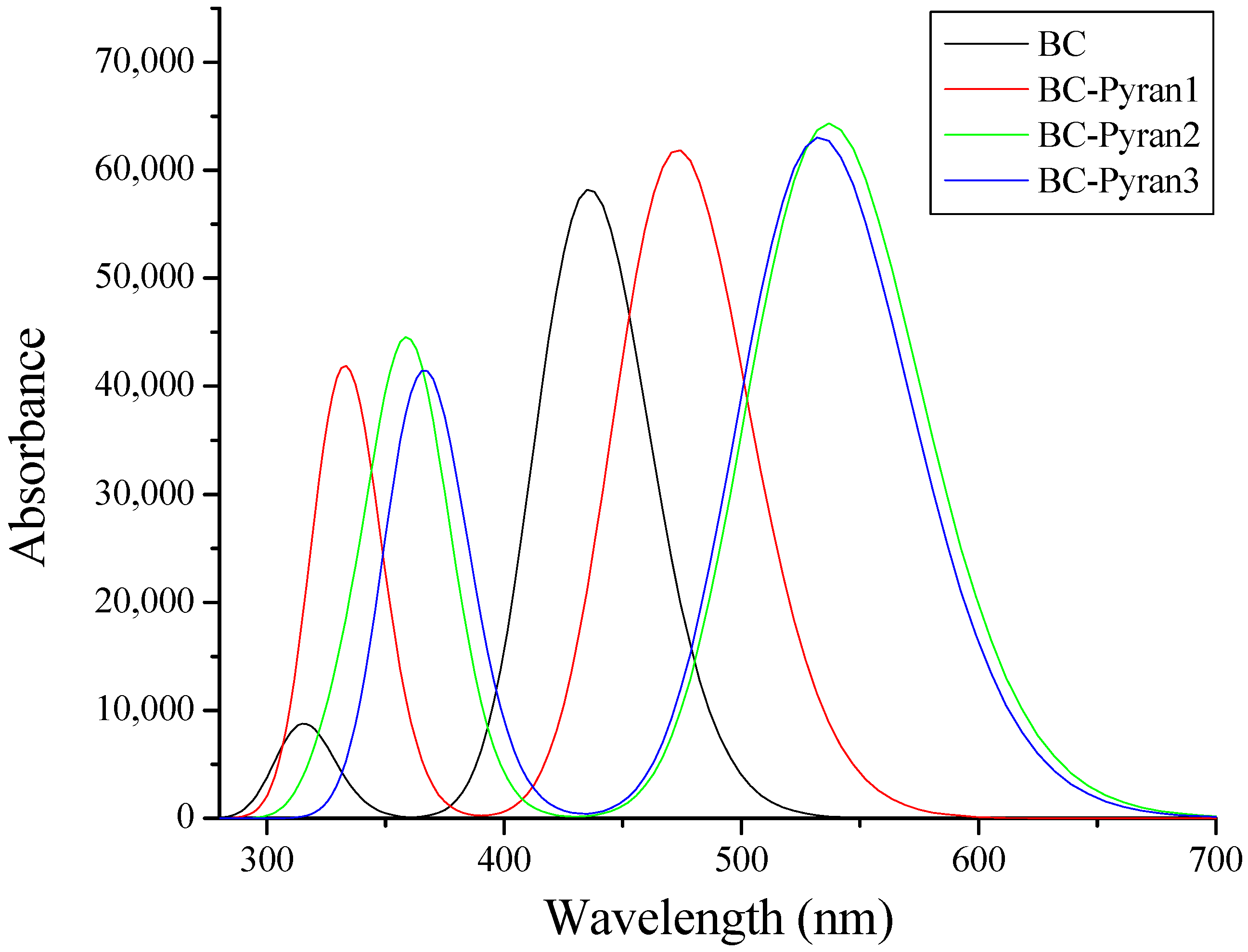Theoretical Investigation of the Effects of Aldehyde Substitution with Pyran Groups in D-π-A Dye on Performance of DSSCs
Abstract
:1. Introduction
2. Chemical Design
3. Results
4. Computational Methods
5. Conclusions
Supplementary Materials
Author Contributions
Funding
Institutional Review Board Statement
Informed Consent Statement
Data Availability Statement
Conflicts of Interest
References
- Fan, H.; Zhu, X. Development of small-molecule materials for high-performance organic solar cells. Sci. China Chem. 2015, 58, 922–936. [Google Scholar] [CrossRef]
- Gao, W.; Ma, R.; Peña, T.A.D.; Yan, C.; Li, H.; Li, M.; Wu, J.; Cheng, P.; Zhong, C.; Wei, Z.; et al. Efficient all-small-molecule organic solar cells processed with non-halogen solvent. Nat. Commun. 2024, 15, 1946. [Google Scholar] [CrossRef] [PubMed]
- Chen, H.; Hu, D.; Yang, Q.; Gao, J.; Fu, J.; Yang, K.; He, H.; Chen, S.; Kan, Z.; Duan, T.; et al. All-Small-Molecule Organic Solar Cells with an Ordered Liquid Crystalline Donor. Joule 2019, 3, 3034–3047. [Google Scholar] [CrossRef]
- Lee, C.P.; Li, C.T.; Ho, K.C. Use of organic materials in dye-sensitized solar cells. Mater. Today Proc. 2017, 20, 267–283. [Google Scholar] [CrossRef]
- Obotowo, I.; Obot, I.; Ekpe, U.J. Organic sensitizers for dye-sensitized solar cell (DSSC): Properties from computation, progress and future perspectives. J. Mol. Struct. 2016, 1122, 80–87. [Google Scholar] [CrossRef]
- Sen, A.; Putra, M.H.; Biswas, A.K.; Behera, A.K.; Groβ, A. A Brief History of and Insight in the Choice of Sensitizers/Dyes for Dye Sensitized Solar Cells. Available online: https://chemrxiv.org/engage/chemrxiv/article-details/62a21e04bb751904a5487692 (accessed on 15 July 2024).
- Yahya, M.; Bouziani, A.; Ocak, C.; Seferoğlu, Z.; Sillanpää, M. Organic/metal-organic photosensitizers for dye-sensitized solar cells (DSSC): Recent developments, new trends, and future perceptions. Dye. Pigment. 2021, 192, 109227. [Google Scholar] [CrossRef]
- Tan, C.J.; Yang, C.S.; Sheng, Y.C.; Amini, H.; Tsai, H.H. Spacer Effects of Donor-π Spacer-Acceptor Sensitizers on Photophysical Properties in Dye-Sensitized Solar Cells. J. Phys. Chem. C 2016, 120, 21272–21284. [Google Scholar] [CrossRef]
- Chawla, P.; Tripathi, M. Novel improvements in the sensitizers of dye-sensitized solar cells for enhancement in efficiency—A review. Int. J. Energy Res. 2015, 39, 1579–1596. [Google Scholar] [CrossRef]
- Yen, Y.S.; Indumathi, V. Effect of π-Conjugated Spacer in N-Alkylphenoxazine-Based Sensitizers Containing Double Anchors for Dye-Sensitized Solar Cells. Polymers 2021, 13, 1304. [Google Scholar] [CrossRef]
- Xie, X.; Liu, Z.H.; Bai, F.Q.; Zhang, H.X. Performance Regulation of Thieno [3, 2-b] benzothiophene π-Spacer-Based D-π-A Organic Dyes for Dye-Sensitized Solar Cell Applications: Insights from Computational Study. Front Chem. 2019, 6, 676. [Google Scholar] [CrossRef]
- Li, Y.; Sun, C.; Song, P.; Ma, F.; Kungwan, N.; Sun, M. Physical Insight on Mechanism of Photoinduced Charge Transfer in Multipolar Photoactive Molecules. Sci. Rep. 2018, 8, 10089. [Google Scholar] [CrossRef] [PubMed]
- Xu, F.; Testoff, T.T.; Wang, L.; Zhou, X. Cause, Regulation and Utilization of Dye Aggregation in Dye-Sensitized Solar Cells. Molecules 2020, 25, 4478. [Google Scholar] [CrossRef]
- Farokhi, A.; Shahroosvand, H.; Zisti, F.; Pilkington, M.; Nazeeruddin, M.K. Influence of triphenylamine derivatives in efficient dye-sensitized/organic solar cells. J. Mater. Chem. A 2023, 11, 25136–25215. [Google Scholar] [CrossRef]
- Kalipriyadharshini, M.; Raman, A.; Ajantha, J.; Gowthaman, J.B.; Easwaramoorthi, S. Triarylamines—A Versatile Molecular Building Block for Optoelectronic Materials. In Handbook of Materials Science, Volume 1: Optical Materials; Ningthoujam, R.S., Tyagi, A.K., Eds.; Springer Nature: Singapore, 2024; pp. 183–214. [Google Scholar] [CrossRef]
- Bibi, S.; Imtiaz, A.; Muhammad, S.; Urrehman, S.; Chaudhry, A.R.; Al-Sehemi, A.G.; Alqurashy, B.A.; Gilani, M.A. Tailoring the donor moieties in TPA -based organic dyes for efficient photovoltaic, optical and nonlinear optical response properties. Int. J. Quantum Chem. 2024, 124, e27362. [Google Scholar] [CrossRef]
- Lee, S.W.; Hussain, W.; Shome, S.; Ha, S.R.; Oh, J.T.; Whang, D.R.; Kim, Y.; Kim, D.-Y.; Choi, H.; Chang, D.W. Effect of electron-withdrawing fluorine and cyano substituents on photovoltaic properties of two-dimensional quinoxaline-based polymers. Sci. Rep. 2021, 11, 24381. [Google Scholar] [CrossRef] [PubMed]
- Zhang, G.; Zhao, J.; Chow, P.C.Y.; Jiang, K.; Zhang, J.; Zhu, Z.; Zhang, J.; Huang, F.; Yan, H. Nonfullerene Acceptor Molecules for Bulk Heterojunction Organic Solar Cells. Chem. Rev. 2018, 118, 3447–3507. [Google Scholar] [CrossRef]
- Arunkumar, A.; Shanavas, S.; Acevedo, R.; Anbarasan, P.M. Acceptor tuning effect on TPA-based organic efficient sensitizers for optoelectronic applications—Quantum chemical investigation. Struct. Chem. 2020, 31, 1029–1042. [Google Scholar] [CrossRef]
- Thavasi, V.; Renugopalakrishnan, V.; Jose, R.; Ramakrishna, S. Controlled electron injection and transport at materials interfaces in dye sensitized solar cells. Mater. Sci. Eng. R Rep. 2009, 63, 81–99. [Google Scholar] [CrossRef]
- Segal-Peretz, T.; Jahnke, J.P.; Berenson, A.; Neeman, L.; Oron, D.; Rossini, A.J.; Chmelka, B.F.; Frey, G.L. Understanding and Promoting Molecular Interactions and Charge Transfer in Dye-Mediated Hybrid Photovoltaic Materials. J. Phys. Chem. C 2014, 118, 25374–25391. [Google Scholar] [CrossRef]
- Roy, A.; Mallick, T.K.; Tahir, A.A.; Gondal, M.A.; Sundaram, S. Chapter Seven—Advanced fabrication strategies to enhance the performance of dye-sensitized solar cells. In Photovoltaics Beyond Silicon; Sundaram, S., Subramaniam, V., Raffaelle, R.P., Nazeeruddin, M.K., Morales-Acevedo, A., Navarro, M.B., Hepp, A.F., Eds.; Elsevier: Amsterdam, The Netherlands, 2024; pp. 223–254. [Google Scholar] [CrossRef]
- Arbouch, I.; Cornil, D.; Karzazi, Y.; Hammouti, B.; Lazzaroni, R.; Cornil, J. Influence of the Nature of the Anchoring Group on Electron Injection Processes at Dye-Titania Interfaces. Phys. Chem. Chem. Phys. 2017, 19, 29389–29401. [Google Scholar] [CrossRef]
- Sharma, S.J.; Prasad, J.; Soni, S.S.; Sekar, N. The impact of anchoring groups on the efficiency of dye-sensitized solar cells: 2-Cyanoacrylic acid vs. ethyl 2-cyanoacrylate. J. Photochem. Photobiol. A Chem. 2023, 444, 114915. [Google Scholar] [CrossRef]
- Liu, S.; Jiao, Y.; Ding, Y.; Fan, X.; Song, J.; Mi, B.; Gao, Z. Position engineering of cyanoacrylic-acid anchoring group in a dye for DSSC applications. Dye. Pigment. 2020, 180, 108470. [Google Scholar] [CrossRef]
- Rahman, S.; Haleem, A.; Siddiq, M.; Hussain, M.K.; Qamar, S.; Hameed, S.; Waris, M. Research on dye sensitized solar cells: Recent advancement toward the various constituents of dye sensitized solar cells for efficiency enhancement and future prospects. RSC Adv. 2023, 13, 19508–19529. [Google Scholar] [CrossRef]
- Nilsing, M.; Persson, P.; Lunell, S.; Ojamäe, L. Dye-Sensitization of the TiO2 Rutile (110) Surface by Perylene Dyes: Quantum- Chemical Periodic B3LYP Computations. J. Phys. Chem. C 2007, 111, 12116–12123. [Google Scholar] [CrossRef]
- Chiu, C.C.; Sheng, Y.C.; Lin, W.J.; Juwita, R.; Tan, C.J.; Tsai, H.H.G. Effects of Internal Electron-Withdrawing Moieties in D–A−π–A Organic Sensitizers on Photophysical Properties for DSSCs: A Computational Study. ACS Omega. 2018, 3, 433–445. [Google Scholar] [CrossRef] [PubMed]
- Suthar, M.; Kumbhani, J.; DBhatt, K. Pyran Heterocyclic Compound as the Prosperous Scaffolds for Biological Sensor (A-Review). Orient. J. Chem. 2021, 37, 1280–1286. [Google Scholar] [CrossRef]
- Wolinski, K.; Brzyska, A. Theoretical studies of the pyranose ring under mechanical stress. Carbohydr. Res. 2018, 470, 64–72. [Google Scholar] [CrossRef]
- Almalki, F.A. An overview of structure-based activity outcomes of pyran derivatives against Alzheimer’s disease. Saudi Pharm. J. 2023, 31, 998–1018. [Google Scholar] [CrossRef]
- Fairlamb, I.; Marrison, L.; Dickinson, J.; Lu, F.J.; Schmidt, J. 2-Pyrones possessing antimicrobial and cytotoxic activities. Bioorganic Med. Chem. 2004, 12, 4285–4299. [Google Scholar] [CrossRef]
- Grover, P.; Bhardwaj, M.; Mehta, L.; Kapoor, G.; Chawla, P. Current Developments in the Pyran-Based Analogues as Anticancer Agents. Anti-Cancer Agents Med. Chem. 2021, 22, 3239–3268. [Google Scholar] [CrossRef]
- Navarro-Tovar, G.; Vega-Rodríguez, S.; Leyva, E.; Loredo-Carrillo, S.; De Loera, D.; López-López, L.I. The Relevance and Insights on 1,4-Naphthoquinones as Antimicrobial and Antitumoral Molecules: A Systematic Review. Pharmaceuticals. 2023, 16, 496. [Google Scholar] [CrossRef] [PubMed]
- Johnson, C.; Darling, S.B.; You, Y. Density functional theory as a guide for the design of pyran dyes for dye-sensitized solar cells. Monatsh. Chem. 2011, 142, 45–52. [Google Scholar] [CrossRef]
- Maglione, C.; Carella, A.; Carbonara, C.; Centore, R.; Fusco, S.; Velardo, A.; Peluso, A.; Colonna, D.; Lanuti, A.; Di Carlo, A. Novel pyran based dyes for application in dye sensitized solar cells. Dye. Pigments. 2016, 133, 395–405. [Google Scholar] [CrossRef]
- Guo, Z.; Zhu, W.; Tian, H. Dicyanomethylene-4H-pyran chromophores for OLED emitters, logic gates and optical chemosensors. Chem. Commun. 2012, 48, 6073–6084. [Google Scholar] [CrossRef]
- El-Shishtawy, R.M.; Elroby, S.A.; Asiri, A.M.; Hilal, R.H. Pyran-Squaraine as Photosensitizers for Dye-Sensitized Solar Cells: DFT/TDDFT Study of the Electronic Structures and Absorption Properties. Int. J. Photoenergy 2014, 2014, 136893. [Google Scholar] [CrossRef]
- Tejada, R.P.; Pellejà, L.; Palomares, E.; Franco, S.; Orduna, J.; Garín, J.; Andreu, R. Novel 4H-pyranylidene organic dyes for dye-sensitized solar cells: Effect of different heteroaromatic rings on the photovoltaic properties. Org. Electron. 2014, 15, 3237–3250. [Google Scholar] [CrossRef]
- Raftani, M.; Abram, T.; Azaid, A.; Kacimi, R.; Bennani, M.N.; Bouachrine, M. New Organic Dyes with Low Bandgap Based on Heterocyclic Compounds for Dye-sensitized Solar Cells Applications. Biointerface Res. Appl. Chem. 2022, 13, 54. [Google Scholar] [CrossRef]
- Napiórkowska, E.; Milcarz, K.; Szeleszczuk, Ł. Review of Applications of Density Functional Theory (DFT) Quantum Mechanical Calculations to Study the High-Pressure Polymorphs of Organic Crystalline Materials. Int. J. Mol. Sci. 2023, 24, 14155. [Google Scholar] [CrossRef]
- Bursch, M.; Mewes, J.M.; Hansen, A.; Grimme, S. Best-Practice DFT Protocols for Basic Molecular Computational Chemistry. Angew. Chem. Int. Ed. 2022, 61, e202205735. [Google Scholar] [CrossRef]
- Abu Alrub, S.; Ali, A.I.; Hussein, R.K.; Alghamdi, S.K.; Eladly, S.A. DFT and TD-DFT Investigations for the Limitations of Lengthening the Polyene Bridge between N, N-dimethylanilino Donor and Dicyanovinyl Acceptor Molecules as a D-π-A Dye-Sensitized Solar Cell. Int. J. Mol. Sci. 2024, 25, 5586. [Google Scholar] [CrossRef]
- Tommalieh, M.J.; Aljameel, A.I.; Hussein, R.K.; Al-heuseen, K.; Alghamdi, S.K.; Alrub, S.A. The Effect of Conjugated Nitrile Structures as Acceptor Moieties on the Photovoltaic Properties of Dye-Sensitized Solar Cells: DFT and TD-DFT Investigation. Int. J. Mol. Sci. 2024, 25, 7138. [Google Scholar] [CrossRef] [PubMed]
- Adeloye, A.; Ajibade, P. Towards the Development of Functionalized PolypyridineLigands for Ru (II) Complexes as Photosensitizers inDye-Sensitized Solar Cells (DSSCs). Molecules 2014, 19, 12421–12460. [Google Scholar] [CrossRef] [PubMed]
- Diez-Cabanes, V.; Fantacci, S.; Pastore, M. First-principles modeling of dye-sensitized solar cells: From the optical properties of standalone dyes to the charge separation at dye/TiO2 interfaces. In Theoretical and Computational Photochemistry; Elsevier: Amsterdam, The Netherlands, 2023; pp. 215–245. [Google Scholar] [CrossRef]
- Gudim, N.S.; Knyazeva, E.A.; Rakitin, O.A. 5-(9-(p-Tolyl)-2,3,4,4a,9,9a-hexahydro-1H-1,4-methanocarbazol-6-yl) thiophene-2-carbaldehyde. Molbank 2024, 2024, M1792. [Google Scholar] [CrossRef]
- Martinez, A. Astaxanthin interacting with metal clusters: Free radical scavenger and photovoltaic materials. Theor. Chem. Acc. 2016, 135, 1–15. [Google Scholar] [CrossRef]
- Sharma, K.; Sharma, V.; Sharma, S.S. Dye-Sensitized Solar Cells: Fundamentals and Current Status. Nanoscale Res Lett. 2018, 13, 381. [Google Scholar] [CrossRef]
- Oliva, R.; Luque, F.J.; Orozco, M. Reliability of MEP and MEP-derived properties computed from DFT methods for molecules containing P, S and CL. Theor. Chem. Acc. 1997, 98, 42–49. [Google Scholar] [CrossRef]
- Ebenso, E.E.; Isabirye, D.E.; Eddy, N.O. Adsorption and Quantum Chemical Studies on the Inhibition Potentials of Some Thiosemicarbazides for the Corrosion of Mild Steel in Acidic Medium. Int. J. Mol. Sci. 2010, 11, 2473–2498. [Google Scholar] [CrossRef] [PubMed]
- Li, Y.; Mi, L.; Wang, H.; Li, Y.; Liang, J. Design, Electron Transfer Process, and Opto-Electronic Property of Solar Cell Using Triphenylamine-Based D-π-A Architectures. Materials 2019, 12, 193. [Google Scholar] [CrossRef] [PubMed]
- Wang, H.; Liu, Q.; Liu, D.; Su, R.; Liu, J.; Li, Y. Computational Prediction of Electronic and Photovoltaic Properties of Anthracene-Based Organic Dyes for Dye-Sensitized Solar Cells. Int. J. Photoenergy 2018, 2018, 4764830. [Google Scholar] [CrossRef]
- Biswas, A.K.; Das, A.; Ganguly, B. Can fused-pyrrole rings act as better π-spacer units than fused-thiophene in dye-sensitized solar cells? A computational study. New J. Chem. 2016, 40, 9304–9312. [Google Scholar] [CrossRef]
- Katoh, R.; Furube, A. Electron injection efficiency in dye-sensitized solar cells. J. Photochem. Photobiol. C Photochem. Rev. 2014, 20, 1–16. [Google Scholar] [CrossRef]
- Ren, S.; Habibi, A.; Ni, P.; Zhang, Y.; Yassar, A. Tuning the Photophysical Properties of Acceptor–Donor–Acceptor Di-2-(2-oxindolin-3-ylidene) Malononitrile Materials via Extended π–Conjugation: A Joint Experimental and Theoretical Study. Materials 2023, 16, 6410. [Google Scholar] [CrossRef]
- Koops, S.; O’Regan, B.; Barnes, P.; Durrant, J. Parameters Influencing the Efficiency of Electron Injection in Dye-Sensitized Solar Cells. J. Am. Chem. Soc. 2009, 131, 4808–4818. [Google Scholar] [CrossRef] [PubMed]
- Ren, S.; Zhang, W.; Wang, Z.; Yassar, A.; Chen, J.; Zeng, M.; Yi, Z. Preparation of Dye Semiconductors via Coupling Polymerization Catalyzed by Two Catalysts and Application to Transistor. Molecules 2023, 29, 71. [Google Scholar] [CrossRef] [PubMed]
- Daeneke, T.; Mozer, A.J.; Uemura, Y.; Makuta, S.; Fekete, M.; Tachibana, Y.; Koumura, N.; Bach, U.; Spiccia, L. Dye Regeneration Kinetics in Dye-Sensitized Solar Cells. J. Am. Chem. Soc. 2012, 134, 16925–16928. [Google Scholar] [CrossRef] [PubMed]
- Chen, J.; Ding, Y.; Zhou, J.; Li, N.; Ren, S.; Zeng, M. Preparation of Novel Organic Polymer Semiconductor and Its Properties in Transistors through Collaborative Theoretical and Experimental Approaches. Polymers 2023, 15, 4421. [Google Scholar] [CrossRef]
- Frisch, M.J.; Trucks, G.W.; Schlegel, H.B.; Scuseria, G.E.; Robb, M.A.; Cheeseman, J.R.; Scalmani, G.; Barone, V.; Mennucci, B.; Petersson, G.A.; et al. Gaussian 09, version A.01; Gaussian Inc.: Wallingford, CT, USA, 2009. [Google Scholar]
- O’boyle, N.M.; Tenderholt, A.L.; Langner, K.M. Cclib: A library for package-independent computational chemistry algorithms. J. Comput. Chem. 2008, 29, 839–845. [Google Scholar] [CrossRef]
- Dassault Systemes Biovia Corp. BIOVIA Materials Studio 2017; Dassault Systemes Biovia Corp.: San Diego, CA, USA, 2017. [Google Scholar]






| Compound | EHOMO (eV) | ELUMO (eV) | (eV) | IP (eV) | EA (eV) |
|---|---|---|---|---|---|
| BC | −5.31 | −1.94 | 3.37 | 5.31 | 1.94 |
| BC-Pyran1 | −5.25 | −2.14 | 3.11 | 5.25 | 2.14 |
| BC-Pyran2 | −5.05 | −2.44 | 2.61 | 5.05 | 2.44 |
| BC-Pyran3 | −5.28 | −2.52 | 2.76 | 5.28 | 2.52 |
| BC + cyanoacrylic group | −5.34 | −2.61 | 2.73 | 5.34 | 2.61 |
| Compound | (eV) | Wavelength (nm) | Oscillator Strength (ƒ) | Transition | Major Contribution |
|---|---|---|---|---|---|
| BC | 2.85 | 435.49 | 0.81 | HOMO→LUMO | 99% |
| BC-Pyran1 | 2.63 | 472.82 | 0.85 | HOMO→LUMO | 99% |
| BC-Pyran2 | 2.32 | 536.66 | 0.89 | HOMO→LUMO | 99% |
| BC-Pyran3 | 2.33 | 532.696 | 0.87 | HOMO→LUMO | 99% |
| Compound | (eV) | (eV) | (eV) | (eV) | (eV) | LHE | (eV) | τ (ns) |
|---|---|---|---|---|---|---|---|---|
| BC | 2.85 | 5.31 | 2.46 | −1.54 | 0.51 | 0.85 | 2.06 | 0.23 |
| BC-Pyran1 | 2.63 | 5.25 | 2.63 | −1.38 | 0.45 | 0.86 | 1.86 | 0.25 |
| BC-Pyran2 | 2.32 | 5.05 | 2.74 | −1.27 | 0.25 | 0.87 | 1.56 | 0.31 |
| BC-Pyran3 | 2.33 | 5.28 | 2.95 | −1.05 | 0.48 | 0.87 | 1.48 | 0.32 |
| Best candidate | BC-Pyran2 | - | - | BC | BC | BC-Pyran2 and BC-Pyran3 | BC | BC-Pyran2 |
| Total Energy (Kcal/mol) | Adsorption Energy (Kcal/mol) | Rigid Adsorption Energy (Kcal/mol) | Deformation Energy (Kcal/mol) | Dye: | DCM: | |
|---|---|---|---|---|---|---|
| BC | −2063.38 | −4173.05 | −2135.33 | −2037.72 | −2100.65 | −8.63 |
| BC-Pyran1 | −2068.47 | −4363.10 | −2138.70 | −2224. 40 | −2289.77 | −10.18 |
| BC-Pyran2 | −2063.26 | −6399.78 | −2132.81 | −4266.97 | −4325.64 | −8.92 |
| BC-Pyran3 | −2076.47 | −6365.01 | −2161.74 | −4203.27 | −4258.79 | −9.92 |
Disclaimer/Publisher’s Note: The statements, opinions and data contained in all publications are solely those of the individual author(s) and contributor(s) and not of MDPI and/or the editor(s). MDPI and/or the editor(s) disclaim responsibility for any injury to people or property resulting from any ideas, methods, instructions or products referred to in the content. |
© 2024 by the authors. Licensee MDPI, Basel, Switzerland. This article is an open access article distributed under the terms and conditions of the Creative Commons Attribution (CC BY) license (https://creativecommons.org/licenses/by/4.0/).
Share and Cite
Alghamdi, S.K.; Aljameel, A.I.; Hussein, R.K.; Al-heuseen, K.; Aljaafreh, M.J.; Ezzat, D. Theoretical Investigation of the Effects of Aldehyde Substitution with Pyran Groups in D-π-A Dye on Performance of DSSCs. Molecules 2024, 29, 4175. https://doi.org/10.3390/molecules29174175
Alghamdi SK, Aljameel AI, Hussein RK, Al-heuseen K, Aljaafreh MJ, Ezzat D. Theoretical Investigation of the Effects of Aldehyde Substitution with Pyran Groups in D-π-A Dye on Performance of DSSCs. Molecules. 2024; 29(17):4175. https://doi.org/10.3390/molecules29174175
Chicago/Turabian StyleAlghamdi, Suzan K., Abdulaziz I. Aljameel, Rageh K. Hussein, Khalled Al-heuseen, Mamduh J. Aljaafreh, and Dina Ezzat. 2024. "Theoretical Investigation of the Effects of Aldehyde Substitution with Pyran Groups in D-π-A Dye on Performance of DSSCs" Molecules 29, no. 17: 4175. https://doi.org/10.3390/molecules29174175
APA StyleAlghamdi, S. K., Aljameel, A. I., Hussein, R. K., Al-heuseen, K., Aljaafreh, M. J., & Ezzat, D. (2024). Theoretical Investigation of the Effects of Aldehyde Substitution with Pyran Groups in D-π-A Dye on Performance of DSSCs. Molecules, 29(17), 4175. https://doi.org/10.3390/molecules29174175






